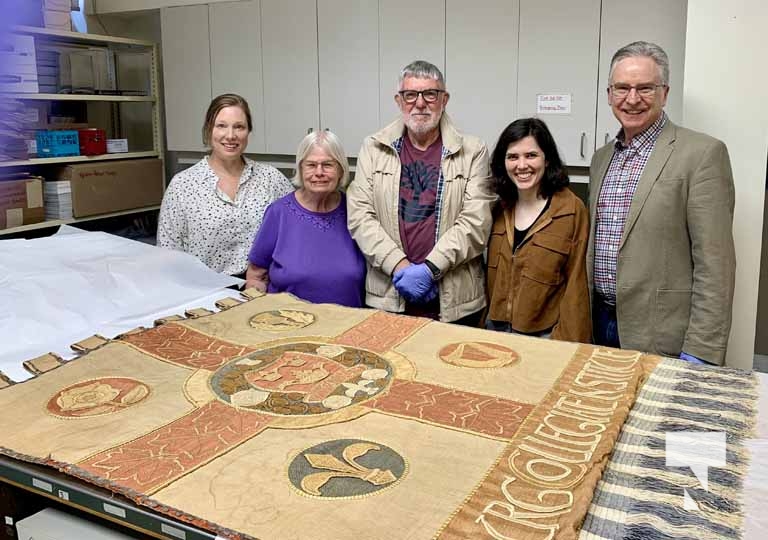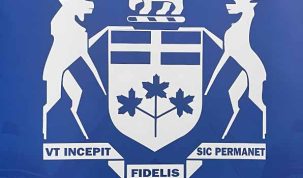By Cecilia Nasmith/Today’s Northumberland
The Northumberland County Archives and Museum welcomed a visitor from the United Kingdom Thursday, hoping to help in her hunt to rediscover historic banners linked to Governor General Earl Grey..
Finding these banners – which were gifted to Canadian educational institutions from students in the UK in the early 1900s – is the mission of researcher Hilary Calvert of Cambridge, England.
Albert, 4th Earl Grey was Canada’s Governor General from 1904 to 1911. During that time, he sought to promote national unity and cohesion within the British Empire. To that end, one of his projects was a program connecting the youth of these two nations by asking his contemporaries in England to create and provide banners embroidered with the figure of St, George. These banners were presented to selected Canadian post-secondary schools to be hung where students would see them every day.
Earl Grey aimed to match schools in England with similar Canadian secondary schools, and he hoped the banners would inspire friendship and understanding between them.
Professionally stitched pieces with complex representations of St. George went to universities, while secondary schools received simpler designs hand-stitched by students.
Cobourg Collegiate Institute was presented its banner in May 1910 by Tynemouth High School in Northumberland, England. CCI became CDCI West in the 1960s, when CDCI East was built, but the banner remained at the school until CDCI West closed in 2015. At that time, it was donated to NCAM.
It is a beautifully created banner with three crowns in the centre of the shield representing the Arms of the Tynemouth Priory. The Rose, Thistle, Fleur de Lys and Harp represent England, Scotland, France and Ireland.
Calvert became interested in Earl Grey banners almost 20 years ago, when a banner made by Mary Seton Watts was returned to England on loan for an exhibition of her work at Watts Gallery in Compton, England. Having researched all she could from Earl Grey’s correspondence (and with endless on-line help and encouragement from institutions throughout Canada), she is now delighted to be travelling across Canada, from Edmonton to Halifax, with stops in Guelph, Cobourg, Kingston and Montreal to see and record as many of these banners as she can.
Calvert has located 13 banners in total, but her research leads her to believe there are still many more school banners unaccounted for. She would be grateful to hear of any others that have survived, lasting more than 100 years, perhaps hung unattributed on library walls or stored in Canadian museums and archives.
“Previous research on Earl Grey’s banners has never explored the banners shared with schools,” she explained.
“With the help of Cobourg District Historical Society and the Northumberland County Archives and Museum, I’m able to understand the full scope of Earl Grey’s ambitious vision. Pictures just cannot replace the value of seeing the skillful embroidery and craftsmanship in person.”
Calvert’s cross-Canada tour coincides with Museum Month and International Museums Day. This year’s theme Museums for Education and Research stresses the pivotal role of cultural institutions in providing a holistic and educational experience.
“It is the core work of archives and museums to preserve materials to provide an enriched understanding of our past and our connections with one another,” NCAM Archivist Abigail Miller agreed, adding that they were thrilled to support Calvert’s research.
Anyone interested in viewing Earl Grey’a banner can contact the NCAM team to make an appointment. For more information, visit //Northumberland.ca/NCAM























